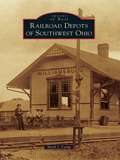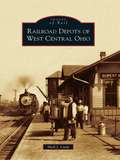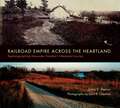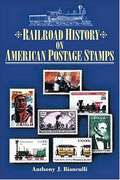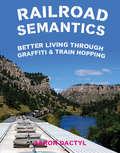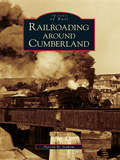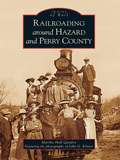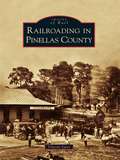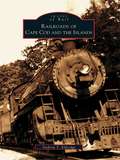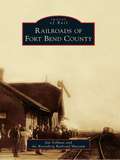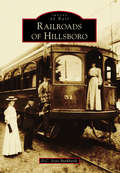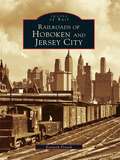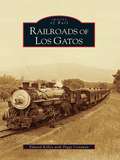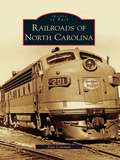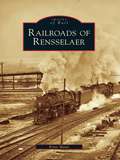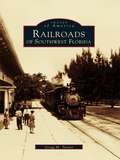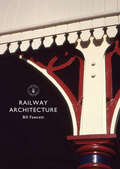- Table View
- List View
Rail Depots of Eastern North Carolina (Images of Rail)
by Larry K. Neal Jr.Railroads have been an integral part of North Carolina since the 1850s, allowing goods and people to travel across the state or to other areas of the country. For many years, the main focus of small towns and large cities in the state was the railroad depots. Residents could purchase train tickets, businesses sought to ship or receive goods for market, and kids loved to visit and wave to the passing train crews. During the Christmas season, presents ordered from catalogs would arrive by Railway Express and were delivered to homes across the area. Mail was also delivered by rail to the depots, even if the train did not stop at a particular community. This book hopes to provide rail enthusiasts, local and economic historians, and history lovers in general a look back at the heyday of railroads and how much they affected daily life in North Carolina.
Railroad Depots of Central Ohio
by Mark J. CampBy the mid-1850s, the railroad craze had hit central Ohio. Pioneer railroads that were to evolve into portions of the Baltimore and Ohio, New York Central, and Pennsylvania Railroads connected the state capital, Columbus, with the canals, Lake Erie, and the Ohio River. The region was crisscrossed by numerous other lines by 1880; Columbus became the main hub while other railroad centers included Circleville, Delaware, Mansfield, Mount Vernon, Newark, and Zanesville. Hundreds of depots were built throughout central Ohio to serve railroad passengers and to handle baggage, mail, and freight. Depots became the center of commerce and activity at communities--big and small. With the discontinuance of passenger trains across the Buckeye State, many depots disappeared from trackside--many simply demolished, others relocated for non-railroad uses. Railroad Depots of Central Ohio offers a pictorial history of selected depots, centering around Columbus and Franklin County, using old postcards and vintage photographs.
Railroad Depots of Northwest Ohio
by Mark J. CampChartered as early as 1832, Northwestern Ohio railroads were among the first in the Midwest. Toledo, a rapidly developing lake port at the mouth of the Maumee River, was the destination point for many lines; others were just passing through on their way to Chicago and points west. By 1907, 20 lines served the northwestern counties. All had a series of stations along their lines, often with depots or other railroad structures. Although many have come and gone, Northwest Ohio was once home to over 250 passenger or combination depots serving the traveling public. Railroad Depots of Northwest Ohio relives the golden age of railroad travel through vintage postcards and mid-20th century photos of selected depots and related structures.
Railroad Depots of West Central Ohio (Images of Rail)
by Mark J. CampTwelve railroad lines served west central Ohio around 1907 and were the lifeblood of the communities they ran through. Bellefontaine, Bradford, and Crestline became major terminals, and lesser known places like Dola, Ohio City, and Peoria also owe their existence to the iron horse. Around 300 depots served the west central region, with the earliest dating to the late 1840s. The depot was the center of activity in the smallest village to the largest city. Many of the depots no longer exist--victims of progress, nature, or neglect. Some survive as historical museums, various businesses, and residences; a few remain in railroad use. The proud history of railroading lives on in the restored depots at Bucyrus and Galion--two architectural gems of the Buckeye State. Railroad Depots of West Central Ohio shares a tale of the golden age of rail travel through vintage postcards and mid-20th-century photographs of selected depots and other railroad structures.
Railroad Empire across the Heartland: Rephotographing Alexander Gardner's Westward Journey
by James E. SherowBest known for his Civil War photographs, Alexander Gardner also documented the construction of the Union Pacific Railway, Eastern Division (later the Kansas Pacific Railroad), across Kansas beginning in 1867. This book presents recent photographs by John R. Charlton of the scenes Gardner recorded, paired with the Gardner originals and accompanied by James E. Sherow&’s discussion. Like most rephotography projects, this one provides fascinating information about the changes in the landscape over the last century and a half.The book presents ninety pairs of Gardner&’s and Charlton&’s photographs. In all of Charlton&’s photos he duplicates the exact location and time of day of the Gardner originals. Sherow uses the paired images to show how Indian and Anglo-American land-use practices affected the landscape. As the Union Pacific claimed, the railroad created an American empire in the region, and Charlton&’s rephotography captures the transformation of the grasslands, harnessed by the powerful social and economic forces of the railroad.
Railroad History on American Postage Stamps
by Anthony J. BianculliCovering a span of almost two centuries, Railroad History on American Postage Stamps tells the stories behind the many United States postage stamps that portray railroad history. Almost 200 stamps depicting railroading highlights including land grants, the completion of the transcontinental railroad, railroad heroes (from John Henry to Casey Jones), and equipment from famous locomotives to workaday freight cars are described in fascinating vignettes. In addition, a major chapter covers railroad issues, labor and the law. There is even a section identifying many famous individuals with surprising railroad associations including Irving Berlin, Nelly Bly, John Wayne, Samuel Clemens, Emily Dickinson, Will Rogers and Cary Grant. Extensively researched by the author over a period of more than two years, the book treats the reader to a treasure trove of little-known yet interesting facts that capture the reader?s attention from the first page to last. Includes an extensive bibliography and Scott Number index.
Railroad Semantics: Better Living Through Graffiti & Train Hopping
by Aaron DactylDevoted to train-hopping, graffiti, and railroad culture, Aaron Dactyl's Railroad Semantics series describes the sights, sounds, successes, and defeats of exploring the western U.S. by freight train. The first four Railroad Semantics books are collected here for the first time. In their pages, you'll see epic, hidden works of art, read up on rail lore and riding tips, meet rail workers and fellow adventurers, and experience the perils and glories of life in rail yards, train cars, small towns, and encampments.
Railroad Semantics: Train Hopping Across Montana, Wyoming, Utah, Nevada, California, and Oregon
by Aaron DactylIn the fourth Railroad Semantics collection, Aaron takes you along on an epic train journey through desolate stretches of Wyoming, Colorado, and Utah. His personal accounts of train hopping are paired with newspaper clippings, photos, rail yard graffiti, and ephemera to fill in the story. In this volume, Aaron survives encounters with police, railroad workers, and hipsters posing as hobos. He drinks under overpasses, is injured alone in the desert, and even takes a legitimate, ticketed Amtrak ride.
Railroading around Cumberland
by Patrick H. StakemLocated at the confluence of Will's Creek and the Potomac River, Cumberland, Maryland, is known as the Queen City of the Alleghenies. Because of the unique geography of the mountain passes, Cumberland became a transportation nexus between the Eastern Seaboard and the inland bounty of the United States. The National Road, a federal project initiated by Pres. Thomas Jefferson, passes through Cumberland, as does the Chesapeake and Ohio Railroad and Canal. Rail lines and roads stretch out west, south, and north to industrial, agricultural, and natural resource areas. Regional short-line railroads served to move coal to the loading docks of the canal in Cumberland. Today the Western Maryland Scenic Railroad features steam-power excursions from the old Western Maryland Station next to the canal basin, while 6,000-horsepower diesels haul heavy freight through the CSX Yards in South Cumberland.
Railroading around Hazard and Perry County
by Martha Hall Quigley John G. KinnerBesides the 1795 settling of what later became Hazard, Kentucky, and the establishment of Perry County in 1821, no other event has had the historical significance of the coming of the railroad. Until the track-laying train came through the tunnel north of town and stopped briefly for a celebration, Hazard was landlocked, and the townspeople had never heard the earthshaking sound of the train whistle. Before the railroad, the river was their road. The only few household conveniences known to these isolated people were laboriously brought up the river on push boats. Many materials used to build the railroad were also transported on flatboats. As a bridge and tunnel were built, and a passage was made for the engine that carried the railroad ties, John G. Kinner documented the change with his camera. Images of Rail: Railroading Around Hazard and Perry County features John G. Kinner's vivid and historic\photographs and others from the Bobby Davis Museum collection.
Railroading in Pinellas County
by Vincent LuisiPinellas County's railroad heritage began in 1888 and lasted almost a century. Today few people who walk, run, or bike the 41-mile Pinellas Trail realize the importance of this path as they travel through Pinellas County railroad history. Railroading in Pinellas County transports the reader through 100 years. History is brought to life through photographs of the individuals who brought to Pinellas the railroad, railroad stations, railroad engines, passenger and freight cars, railroad companies, employees, and industries such as tourism that utilized this form of transportation. These photographs were culled with the assistance and permission of local historical societies, county and state archives, and various private collections.
Railroads of Cape Cod and the Islands
by Andrew T. EldredgeIn 1848, the railroad extended to Cape Cod to serve the Boston & Sandwich Glass Company. By 1887, fourteen of the fifteen towns on Cape Cod were connected by the railroad. For a short time, even the islands of Nantucket and Martha's Vineyard had railroad lines. As the highways expanded in the years following World War II, the automobile became the primary mode of transportation. By 1959, year-round Cape Cod passenger service had been discontinued. Today, many miles of track have been removed to accommodate recreational bike paths.Using hundreds of historic images, Railroads of Cape Cod and the Islands illustrates the rich heritage of passenger and freight rail transportation on Cape Cod, Martha's Vineyard, and Nantucket. Mainland connections once involved transfer between ship and rail at wharves in Provincetown, Hyannis, and Woods Hole. Since 1935, trains have crossed the Cape Cod Canal on the world's second longest vertical-lift bridge.
Railroads of Fort Bend County (Images of Rail)
by Jim Vollmar Rosenberg Railroad MuseumFort Bend County was formed in the early 1820s by members of Stephen F. Austin's "Old 300." Traders utilized barges and steamboats running along the Brazos River to transport cotton and other products from the lower Brazos Valley to the port at Galveston. In 1853, railroads began to play a larger role in the county's transportation system. Transportation facilities were greatly improved when the first railroad in Texas, the Buffalo, Brazos, and Colorado Railroad Company, completed its first 20-mile segment to Stafford's Point in Fort Bend County from Harrisburg (Houston). As many as eight separate railroads were chartered and operated in Fort Bend County by 1900. Today some of the names have changed but most of the original rail lines remain in operation. The Union Pacific, Burlington Northern Santa Fe, and Kansas City Southern rail companies have picked up where their predecessors left off and are keeping Fort Bend County one of the busiest and fastest-growing counties in the United States.
Railroads of Hillsboro
by D.C. Jesse BurkhardtHillsboro, Oregon, always seemed destined to be an important railroad town. When the first trains arrived in Hillsboro in 1871 under the banner of the Oregon & California Railroad, the town began to develop into a key railroad junction point. Hillsboro was strategically located just 20 miles from the booming Portland metropolis, a regional center of manufacturing and trade, and by 1911, Hillsboro was where several rail lines branched off. One line headed west toward Tillamook, where the railroad tapped rich timber resources along the Oregon coast. Another line cut south into the fertile Willamette Valley, accessing prime agricultural lands that produced a bounty of wheat and other commodities. A third route carried passengers and goods to and from Portland and the neighboring communities of Cornelius and Forest Grove. As these routes developed, heavy volumes of freight began rolling into Hillsboro. At the same time, travelers moved through Hillsboro on passenger trains, including the Southern Pacific Railroad's famed "Red Electrics" and the Oregon Electric Railway's interurbans, which advertised passenger service with "no soot and no cinders."
Railroads of Hoboken and Jersey City
by Kenneth FrenchWith over two hundred historical photographs, Railroads of Hoboken and Jersey City explores the cultural and commercial effects of railway travel in two important New Jersey cities. Because of their unique location directly across the Hudson River from Manhattan, Hoboken and Jersey City have long been centers of transportation activity. When the railway industry was booming in the early twentieth century, four major passenger terminals dotted the left bank of the Hudson from the Jersey Central to the Pennsylvania to the Erie to the Lackawanna. Thousands of people streamed through these terminals every day to the ferries that then took them across the river to New York City. Additionally, tons of freight were brought through the vast train yards along the waterfront. Railroads of Hoboken and Jersey City tells the history of the railroads between the mid-1800s and the 1970s. It also explores how the once vibrant waterfronts of Hoboken and Jersey City went through tremendous decline and how, over time, the waterfront has been restored and redeveloped. New residential and commercial buildings have sprouted along the old Pennsylvania and Erie properties, the Lackawanna Terminal has been restored, and the Central Railroad Terminal is now part of Liberty State Park, one of New Jersey's most popular tourist destinations.
Railroads of Los Gatos (Images of Rail)
by Peggy Conaway Edward KelleyThe picturesque town of Los Gatos stands between the once verdant orchards of the Santa Clara Valley and the forested slopes of the Santa Cruz Mountains. The narrow-gauge South Pacific Coast Railroad arrived in 1878 and, within two years, laid track over the mountains to carry passengers, redwood, and tons of ripe produce. Less than a decade later it was purchased by Southern Pacific, and completely converted to standard gauge by 1909. Invigorating business and industry, the railroad remained a vital part of the economy of Los Gatos for over 80 years. Although the era of commercial rail ended in 1959, Billy Jones and his scaled-down Wildcat Railroad" still offered weekend rides at his ranch to guests, including Walt Disney. The Wildcat still operates in two local parks today."
Railroads of North Carolina (Images of Rail)
by Alan ColemanSince the opening of the first permanent railway in 1833, hundreds of railroad companies have operated in North Carolina. Rail transportation, faster and more efficient than other methods of the era, opened new markets for the products of North Carolina's farms, factories, and mines. Over the years, North Carolina rail companies have ranged in size from well-engineered giants like the Southern Railway to temporary logging railroads like the Hemlock. Cross ties and rails were laid across almost every conceivable terrain: tidal marshes, sand hills, rolling piedmont, and mountain grades. Vulnerable to the turbulent and unregulated economies of the day, few railroad companies escaped reorganizations and receiverships during their corporate lives, often leaving tangled and contradictory histories in their passing.
Railroads of Rensselaer
by Ernie MannRensselaer was once a classic American railroad town, and like most cities and towns of its type, it was part of an important junction of several destinations. From the 1840s to today, trains have rolled to the four principal compass points from town. Located across the Hudson River from Albany, Rensselaer has seen a rich array of locomotives, structures, and notable trains, all helping to establish Rensselaer's rail prominence and the industry's importance to and involvement in the community. Today Rensselaer hosts the Albany Amtrak station, which sees an average of 775,000 passengers annually and is ranked as the country's 10th busiest station. Using images of rolling stock, buildings, maps, documents, and memorabilia, Railroads of Rensselaer is a visual trip through the years.
Railroads of Southwest Florida
by Gregg M. TurnerWhen the first "Iron Horse" arrived in Southwest Florida--at Charlotte Harbor in 1886--nearly 150,000 miles of railroads already existed in America, the transcontinental route was open, and Pullman sleeping cars were in wide use. But despite a late start, railroads forever transformed this beautiful region of the Sunshine State and connected its people to the outside world. In Railroads of Southwest Florida, the golden age of railroadingis documented with captivating images of stations, machines, and the people whose lives were affected by this significant form of transportation. From interior views of well-furnished passenger cars to scenes of hardworking men who made it all possible, this collection provides a thorough look at a fascinating, almost forgotten heritage.
Railroads, Art, and American Life: An Artist's Memoir
by J. Craig ThorpeExplore the past, present, and future of rail travel through 30 years of one artist's work.Once a common part of the American landscape, trains are increasingly fading from public view. Though photographs can accurately convey the details of "what, where, and when," sometimes paintings can better convey the deeper truths of an era. Collecting more than thirty years of paintings and renderings, Railroads, Art, and American Life tells the story of rail transportation in America through the life and works of artist J. Craig Thorpe. Commissioned by companies such as Amtrak and General Electric, Thorpe's work can be found featured on items ranging from catalogs to calendars, postcards to posters. His artwork depicts not only the golden age of train travel but considers the present and looks forward to a potential future. Featuring more than 130 color illustrations and combining history, biography, ethics, and humor, Thorpe's personal story joins with his paintings to invite the reader to relive the heyday of American rail and better understand the role of railroads in our society today.
Rails Around Fort Worth
by Ian TaylorRailways played a central role in the development of the American West. The railroad came to Fort Worth in 1876, and with it came the boom that transformed a city into a metropolis. From the arrival of the Texas & Pacific Railroad to the streamliners of the postwar era, Fort Worth has always seen the railroad as a vital part of its character. From transcontinental locomotives to the construction of elegant architectural landmarks and to small but convenient interurban passenger lines, railroad history is central to Fort Worth's development. This is the story of a city's love affair with technology, transportation, and industry. Through its connection to an emerging country via the railroad, the young frontier town of Fort Worth came to offer as much to the nation's development as it benefited from it.
Rails in Rochester and Monroe County
by Richard Dick" ChaitFrom photography to farming and from medicine to music, Rochester and the county in which it resides, Monroe County, are known throughout the world. This book brings to life the role that rail transportation had in developing an economy that made these contributions possible. By 1900, some of the county's biggest railroads had been drawn to the Rochester and Monroe County markets. They attracted people and businesses to the area and ensured the flow of products to the marketplace. Trolleys enabled people to commute to and from work as well as to enjoy the recreational resources of Lake Ontario and Irondequoit Bay. Rail transportation helped make Rochester and Monroe County truly great places to live and work.
Railway Architecture
by Bill FawcettA guide to the architecture that gives British railways their identity, from stations to signal boxes.Roots of Britain's railways lie in the wooden-railed colliery wagonways of around 1600, but it was almost 1830 before specific railway architecture became needed. This evolved rapidly down to 1850, and for some time afterwards Britain led the world in designing passenger stations. Though stylistic dress followed contemporary fashions, their handling of space and of large crowds of people was something quite new. Glass and iron were used to produce elegant platform roofs, many exploiting the decorative potential of cast iron. However, the most striking contribution was made by the great arched station sheds, often seen as the 19th century's counterpart to medieval cathedrals. Between the 20th century's two world wars, architectural progress on Britain's railways was largely confined to London Transport, but the last few decades have seen a renewal of confidence and investment, matched by some interesting new buildings.
Railway Centre York: A Pictorial & Historic Survey
by David MatherThe ancient city of York has been closely associated with railways since their conception and promotion by the ‘Railway King’, George Hudson. Its impressive station and engine sheds have played host to the elite of East Coast Main Line traction as well as a wide variety of ‘locals’. The major stabling point of York North shed, coded 50A was home to a diverse collection of steam locomotives as well as welcoming visiting engines from the wider network. As such it attracted interest from enthusiasts not only of steam power but later on as an important diesel depot, finally closing but later to be reborn as the National Railway Museum. Constructed in 1877 it was the largest railway station in the world. Legendary expresses have called at the platforms under the imposing curved glass and iron roof, now a Grade II* listed building. Today’s ‘flyers’ race between London and Edinburgh at speeds unheard of in steam days while cross-country services also bring visitors keen to explore York’s historic and cultural heritage. Yet the sight and sound of steam traction is still a major attraction in this modern era, with crowds flocking to see preserved locomotives at the head of the trains which regularly grace these famous tracks. David Mather has brought together a collection of his images which represents York’s railway heritage from its earliest days through to the present and which shows the city to be still justified in claiming the title ‘Railway Centre’.
Railway Palaces of Portland, Oregon: The Architectural Legacy of Henry Villard (Landmarks)
by Alexander Benjamin CragheadIn 1883, railroad financier Henry Villard brought Portland and the Pacific Northwest their first transcontinental railroad. Earning a reputation for boldness on Wall Street, the war correspondent turned entrepreneur set out to establish Portland as a bourgeoning metropolis. To realize his vision, he hired architects McKim, Mead & White to design a massive passenger station and a first-class hotel. Despite financial panics, lost fortunes and stalled construction, the Portland Hotel opened in 1890 and remained the social heart of the city for sixty years. While the original station was never built, Villard returned as a pivotal benefactor of Union Station, saving its iconic clock tower in the process. Author Alexander Benjamin Craghead tells the story of this Gilded Age patron and the architecture that helped shape the city's identity.


